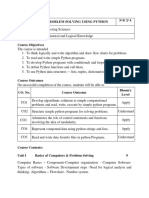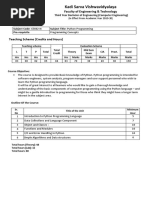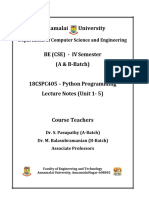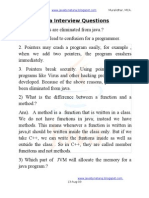Introduction To Python Programming - Theory
Uploaded by
Dhruv SojitraIntroduction To Python Programming - Theory
Uploaded by
Dhruv SojitraEffective From
BHAGWAN MAHAVIR UNIVERSITY (2022-2023)
Diploma Engineering (Computer Engineering)
Semester: V
Teaching Scheme
Subject Examination
Subject Title (Hours/Week) Total
Code Credits Marks
Marks
Theory Tutorial Internal External
Introduction to
Python
1030106502 3 0 3 40 60 100
Programming –
Theory
Duration of Exam: 2:30 Hours
Objective of the course:
To understand why Python is a useful scripting language for developers.
To learn how to design and program Python applications.
To learn how to use lists, tuples, and dictionaries in Python programs.
To learn how to write loops and decision statements in Python.
To learn how to write functions and pass arguments in Python.
To learn how to design object‐oriented programs with Python classes.
To learn how to read and write files in Python.
Course Outcomes:
Upon completion of the course, the student shall be able:
Sr. Marks %
CO statement
No. weightage
CO-1 Describe basic principles in Python. 15
CO-2 Explain basic programming skills in Python. 20
CO-3 Discuss arrays and strings in Python. 15
CO-4 Use list and tuple to perform specific operations. 15
CO-5 Prepare user-defined functions using Python. 20
CO-6 Demonstrate file operations. 15
Registrar Dean- Academics Chairman - BOS
Effective From
BHAGWAN MAHAVIR UNIVERSITY (2022-2023)
Detail Content:
Sr. Total
Unit Topic
No. Hrs.
1.1 Introduction: Features and Application of Python,
Comparison between C and Python
1.2 Basics of Python Syntax: Comments, Variable, Data
types (Built-in data types, User-defined data types),
UNIT – 1
1 Sequences, Sets, Literals, Constants, Identifiers and
Introduction to 08
Python reserved keywords, Naming conventions
1.3 Operators: Types of Operators (Arithmetic, Assignment,
Unary minus, Relational, logical, Boolean, Bitwise,
Membership, Identity), Operator precedence and
associativity
2.1 Array: Creating an Array, Types of Arrays, Indexing and
slicing on arrays, Operations on array
2.2 String: Creating String, Length of a string, Indexing and
slicing in string, Operations on a string (Repeating the
UNIT – 2 strings, Concatenation of strings, comparing strings,
2 Array and String removing spaces from a string, finding substrings, 10
in Python counting substrings in a string, replacing a string with
another string, Splitting, and joining strings, changing
the case of a string, checking starting and ending of a
string)
3.1 Lists: Creating lists using range() function, Updating the
elements of a list, Concatenation of two lists, Repetition
of lists, Membership in lists, Methods to process lists,
Finding elements in list, Sorting list, Finding occurrence
in a list, Storing different types of data in a list.
UNIT – 3 3.2 Tuples: Creating tuples, Accessing the tuple elements,
3 Collections in Basic operations on tuples, Functions to process tuples, 07
Python Nested tuples, Inserting elements in tuple, Modify
elements of tuple, Deleting elements from tuple.
3.3 Dictionaries: Operations on dictionaries, Dictionary
methods, Using for loop with dictionaries, Converting
lists into dictionary, Converting strings into dictionary,
ordered dictionary.
Registrar Dean- Academics Chairman - BOS
Effective From
BHAGWAN MAHAVIR UNIVERSITY (2022-2023)
4.1 Input and Output: I/O Statements, Command line
arguments
UNIT – 4 4.2 Control Statements: If statement, If...else statement,
4 Decision Making If…elif...else statement, Nested if 05
and Loops 4.3 Looping Statements: For Loop, While Loop, Infinite
Loop, Nested Loop, Break and Continue Statement
5.1 Functions: Defining a function, Calling a function,
Local and global variables, Returning results from a
function, Pass by object reference
UNIT – 5 5.2 Types of Arguments: Formal and Actual Arguments,
5 Keyword Arguments, Default Arguments, Variable 06
Functions
Length Arguments, Positional Arguments,
5.3 Recursive functions
5.4 Function decorators, Generators
6.1 OOPs Concepts: Features of OOPS, Creating class and
objects, Class attributes
6.2 Inheritances and their types
UNIT – 6 6.3 Constructor and Destructors
6 OOPs Concepts 6.4 Polymorphism: Method Overloading & Method 09
and Overriding
File handling
6.5 Files: Types of files in Python, Opening and closing a
file, Reading and writing a file, Renaming and deleting
files, With statement, Seek () and tell () methods
List of Open Source Software/learning website:
1. Sublime text
2. Python 3
3. Anaconda
4. https://www.educba.com/software-development/software-development tutorials/python-
tutorial/
5. https://www.pythontutorial.net/
Reference Book:
1. Python Basics: A Practical Introduction to Python 3 by Real Python.
2. Taming Python by Programming, Jeeva Jose, and Khanna Publication.
3. R. Nageswara Rao, “Core Python Programming”, Dreamtech press.
4. Mike McGrath, “Python in Easy Steps: Makes Programming Fun!” Tata McGraw-Hill
Education, 2018.
5. Kenneth A. Lambert, “Fundamentals of Python – First Programs”, CENGAGE Publication.
*******************************************************************
Registrar Dean- Academics Chairman - BOS
You might also like
- Programming and Problem Solving Using PythonNo ratings yetProgramming and Problem Solving Using Python3 pages
- Python Programming - Theory - 1010206302No ratings yetPython Programming - Theory - 10102063023 pages
- 3-Year Under Graduate Programme in Mathematics Revamped Curriculum Design and Model SyllabusNo ratings yet3-Year Under Graduate Programme in Mathematics Revamped Curriculum Design and Model Syllabus2 pages
- 22PLU105B 205B IntroductionToPython-22PLC1052No ratings yet22PLU105B 205B IntroductionToPython-22PLC10523 pages
- Introduction To Python Programing: Unit-1No ratings yetIntroduction To Python Programing: Unit-11 page
- Problem Solving and Python Programming L T P CNo ratings yetProblem Solving and Python Programming L T P C1 page
- PROBLEM SOLVING AND PYTHON PROGRAMMING L T P C - LogNo ratings yetPROBLEM SOLVING AND PYTHON PROGRAMMING L T P C - Log1 page
- CCA SANSKRITI CHAUHAN REPORT PLC (1) (1)No ratings yetCCA SANSKRITI CHAUHAN REPORT PLC (1) (1)12 pages
- bca syllabus 2024 - 2025 FINAL I YEAR (1)No ratings yetbca syllabus 2024 - 2025 FINAL I YEAR (1)13 pages
- Mca2022 - Advanced Python-Programming - (Elective)No ratings yetMca2022 - Advanced Python-Programming - (Elective)2 pages
- Course Overview:: Course Name: Programming Essential in Python Instructor Name: Shaheryar NajamNo ratings yetCourse Overview:: Course Name: Programming Essential in Python Instructor Name: Shaheryar Najam3 pages
- Mastering Python: A Comprehensive Guide to ProgrammingFrom EverandMastering Python: A Comprehensive Guide to ProgrammingNo ratings yet
- Basics of Python Programming: A Quick Guide for BeginnersFrom EverandBasics of Python Programming: A Quick Guide for BeginnersNo ratings yet
- Aim:-Write, Test and Debug Small Applications With Basic HTML. #CODENo ratings yetAim:-Write, Test and Debug Small Applications With Basic HTML. #CODE98 pages
- Bhagwan Mahavir University: Diploma Engineering (Electronics and Communication Engineering)No ratings yetBhagwan Mahavir University: Diploma Engineering (Electronics and Communication Engineering)4 pages
- Aim:-Write, Test and Debug Small Applications With Basic HTML. #CODENo ratings yetAim:-Write, Test and Debug Small Applications With Basic HTML. #CODE98 pages
- Computer Engineering.: SR No. Unit Practical Exercises/Experiments Approx. Hrs. Required 1 1 1 2No ratings yetComputer Engineering.: SR No. Unit Practical Exercises/Experiments Approx. Hrs. Required 1 1 1 278 pages
- Introduction To Python Programming - PracticalNo ratings yetIntroduction To Python Programming - Practical3 pages
- C++20 for Programmers: An Objects-Natural Approach 3rd Edition Paul Deitel download pdf100% (1)C++20 for Programmers: An Objects-Natural Approach 3rd Edition Paul Deitel download pdf55 pages
- Java Precisely third edition Peter Sestoft download100% (1)Java Precisely third edition Peter Sestoft download66 pages
- CSE BTECH IV SEM SCHEME SYLLABUS - Jan 2022No ratings yetCSE BTECH IV SEM SCHEME SYLLABUS - Jan 202216 pages
- [Ebooks PDF] download Ruby for Rails Ruby techniques for Rails developers David Black full chapters100% (9)[Ebooks PDF] download Ruby for Rails Ruby techniques for Rails developers David Black full chapters60 pages
- Chapter 1 - Object-Oriented FundamentalsNo ratings yetChapter 1 - Object-Oriented Fundamentals16 pages
- CP1404 - Assignment 2 - Movies To Watch 2.0 (Part 1 ONLY) : TaskNo ratings yetCP1404 - Assignment 2 - Movies To Watch 2.0 (Part 1 ONLY) : Task5 pages
- Openquant 2014 Faq: Frequently Asked QuestionsNo ratings yetOpenquant 2014 Faq: Frequently Asked Questions22 pages
- Java 4 - Java's Type System and Collection Classes - DecryptedNo ratings yetJava 4 - Java's Type System and Collection Classes - Decrypted179 pages
- Java Interview Questions: 1 Muralidhar, MCANo ratings yetJava Interview Questions: 1 Muralidhar, MCA51 pages





































































































